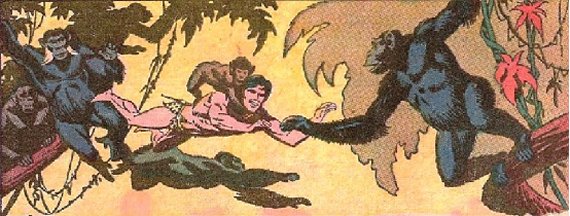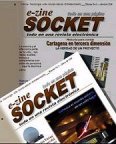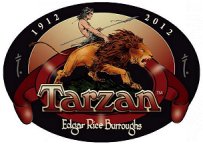Introduction
 Mangani is considered
one of the more fascinating fictional languages, since its grammar allows
any person to understand it quickly, because of its simplicity and structural
organization. Currently, Mangani has been developed with a similarity to
many African languages, but without the grammatical complexity of these
dialects. In order to learn Mangani you should take into account some basic
rules as a guide in the way that it has to be expressed.
Mangani is considered
one of the more fascinating fictional languages, since its grammar allows
any person to understand it quickly, because of its simplicity and structural
organization. Currently, Mangani has been developed with a similarity to
many African languages, but without the grammatical complexity of these
dialects. In order to learn Mangani you should take into account some basic
rules as a guide in the way that it has to be expressed.
This new compendium allows readers to understand the language more accurately
and to create complete sentences with actions, predicates and implicit
subject, by using parts of the sentence that are complied strictly in the
Mangani.
Although in the course of the investigation new words were generated,
they combine perfectly with the words created by Edgar Rice Burroughs in
1912. The textual content of the novels and therefore the cartoons in the
comics, will not change. Today the Mangani is a complete language, understandable
and widespread, which follows the same trend originally proposed in the
novels.
From about 340 words, Mangani currently has more than 2500 words etymologically
related to the former. Although we can create any sentence with this
language, it has been determined to specify their areas and contexts of
use, framed by their origins in the novels. These contexts are: Anatomy,
Animals, Botany, Colors, Dressing, Family, Political Structure, Geography,
Nouns, Verbs and Weapons. The respective words were grouped in a dictionary
which can be obtained at Burroughs' Ape Language Compilations
There is still much to investigate and develop in relation to this language.
This is a good start which gives us the ability to take you to other areas
or contexts, looking for a way to keep an updated language model that can
express aspects of natural life in an ape-man relationship.
Main research
Through reading and studying the pages of the novel Tarzan of the
Apes, comics, and many other documents related to apes, the way they
communicate, the sounds they emit, etc., we established this complete compendium,
starting from the place where Tarzan was born and the lands around that
point, on the African occidental coast.
We have explained how the influence of Bantú, Portuguese and
Spanish could generate many dialects around those places, where many tribes
of black men adopted their languages. In the same way, we explained
how a child could produce some words in a natural context, expressed by
his own creativity, since his biological constitution was in perfect condition
having listened to his mother during his first year of life.
This hypothesis gave us the idea that in effect the language could be
generated by naming the different species, events and sensations that we
can find in a big forest, instead of by imitating those sounds, according
to the thought of Edgar Rice Burroughs. www.erbzine.com/mag21/2112.html
But the first words created by Edgar Rice Burroughs, did not seem to
obey any specific order, so we started by studying them, understanding
the context of each word, organizing them in groups, and later their syntax,
to produce the new words that would give the aspect as an African language.
Grammatical Rules
These are the different parts of the Mangani grammar
we could establish as rules in order to be more easily understood:

 Mangani is considered
one of the more fascinating fictional languages, since its grammar allows
any person to understand it quickly, because of its simplicity and structural
organization. Currently, Mangani has been developed with a similarity to
many African languages, but without the grammatical complexity of these
dialects. In order to learn Mangani you should take into account some basic
rules as a guide in the way that it has to be expressed.
Mangani is considered
one of the more fascinating fictional languages, since its grammar allows
any person to understand it quickly, because of its simplicity and structural
organization. Currently, Mangani has been developed with a similarity to
many African languages, but without the grammatical complexity of these
dialects. In order to learn Mangani you should take into account some basic
rules as a guide in the way that it has to be expressed.




